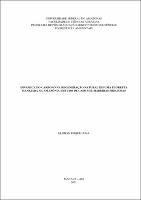| ???jsp.display-item.social.title??? |


|
Please use this identifier to cite or link to this item:
https://tede.ufam.edu.br/handle/tede/8153| ???metadata.dc.type???: | Dissertação |
| Title: | Dinâmica do carbono na regeneração natural em uma floresta manejada na Amazônia: estudo de caso Mil Madeiras Preciosas |
| Other Titles: | Carbon dynamics in natural regeneration in a forest managed in the Amazon: a case study of Mil Precious Woods |
| ???metadata.dc.creator???: | Luna, Elifran Roque  |
| ???metadata.dc.contributor.advisor1???: | Azevedo, Celso Paulo de |
| First advisor-co: | Souza, Cintia Rodrigues de |
| ???metadata.dc.contributor.referee1???: | Pinto, Luís Antônio de Araújo |
| ???metadata.dc.contributor.referee2???: | Pinto, Alberto Carlos Martins |
| ???metadata.dc.description.resumo???: | O futuro da Floresta Amazônica e as consequências que o desmatamento pode causar a mudança climática têm sido cada vez mais discutidos pela sociedade. Dessa forma, conhecer as consequências que as operações florestais irão trazer para a dinâmica das florestas manejadas é de extrema importância, mas precisamente nos termos da floresta está agindo como fonte ou sumidouro de carbono. Por esse motivo é importante estudar o ciclo do carbono na regeneração natural, já que a maior parte dos estudos de biomassa e carbono em florestas nativas se concentra na avaliação do estrato superior. Este trabalho utilizou dados de inventários florestais contínuos realizados na Fazenda Dois Mil, pertencente à empresa Mil Madeiras Preciosas, localizada no município de Itacoatiara-AM. O objetivo deste trabalho foi quantificar o estoque de carbono presente na regeneração natural de uma floresta manejada, assim como estudar a dinâmica do carbono e avaliar em diferentes períodos de monitoramento como a regeneração está se comportando após a exploração florestal. Os inventários foram realizados nos anos de 1996, 1997, 1998, 2001, 2014 e 2019. Foi considerado regeneração natural da floresta os indivíduos com 5 cm ≥ DAP < 15 cm. O carbono estimado para área de estudo foi de 13,0178 ± 2,1009 t.ha-1. O Incremento Periódico Anual em carbono apresentou variações entre 0,1814 a 0,5868 t.ha-1ano-1. As taxas de ingresso e mortalidade foram de 18,02% e 32,52. As UPAS B, C e D não apresentaram diferença estatística significativa em relação ao estoque, incremento, ingresso e mortalidade. Vale lembrar que elas tiveram diferença na intensidade de corte. O fator preponderante que influenciou diretamente na variação do carbono nos diferentes períodos de acompanhamento foi o tempo. A floresta manejada recuperou o estoque de carbono quando foram comparados os valores da medição anterior à exploração com os valores das duas últimas medições após a exploração, mostrando assim a capacidade de se recuperar após a atividade de manejo florestal. |
| Abstract: | The future of the Amazon Forest and the consequences that deforestation can cause to climate change have been increasingly discussed by society. Thus, knowing the consequences that forest operations will bring to the dynamics of managed forests is extremely important, but precisely in terms of the forest it is acting as a carbon source or sink. For this reason, it is important to study the carbon cycle in natural regeneration, since most studies of biomass and carbon in native forests focus on the assessment of the upper strata. This work used data from continuous forest inventories carried out at Fazenda Dois Mil, owned by the company Mil Madeiras Preciosas, located in the municipality of Itacoatiara-AM. The objective of this work was to quantify the carbon stock present in the natural regeneration of a managed forest, as well as to study the carbon dynamics and to evaluate in different monitoring periods how the regeneration is behaving after the forest exploration. The inventories were carried out in the years 1996, 1997, 1998, 2001, 2014 and 2019. Individuals with 5 cm ≥ DBH <15 cm were considered natural regeneration of the forest. The estimated carbon for the study area was 13.0178 ± 2.2009 t.ha-1. The Annual Periodic Increment in carbon varied between 0.1814 to 0.5868 t.ha-1year-1. The entry and mortality rates were 18.02% and 32.52. UPAS B, C and D showed no statistically significant difference in relation to stock, increase, income and mortality. It is worth remembering that they had a difference in cutting intensity. The predominant factor that directly influenced the variation in carbon in the different monitoring periods was time. The managed forest recovered the carbon stock when the values of the measurement prior to logging were compared with the values of the last two measurements after logging, thus showing the ability to recover after forest management activity. |
| Keywords: | Biomassa florestal Floresta manejada Desmatamento Inventários florestais Florestas nativas |
| ???metadata.dc.subject.cnpq???: | CIÊNCIAS AGRÁRIAS |
| ???metadata.dc.subject.user???: | Amazônia Manejo florestal Regeneração natural Dinâmica Carbono |
| Language: | por |
| ???metadata.dc.publisher.country???: | Brasil |
| Publisher: | Universidade Federal do Amazonas |
| ???metadata.dc.publisher.initials???: | UFAM |
| ???metadata.dc.publisher.department???: | Faculdade de Ciências Agrárias |
| ???metadata.dc.publisher.program???: | Programa de Pós-graduação em Ciências Florestais e Ambientais |
| Citation: | LUNA, Elifran Roque. Dinâmica do carbono na regeneração natural em uma floresta manejada na Amazônia: estudo de caso Mil Madeiras Preciosas. 2021. 63 f. Dissertação (Mestrado em Ciências Florestais e Ambientais) - Universidade Federal do Amazonas, Manaus, 2021. |
| ???metadata.dc.rights???: | Acesso Aberto |
| ???metadata.dc.rights.uri???: | http://creativecommons.org/licenses/by-nc-nd/4.0/ |
| URI: | https://tede.ufam.edu.br/handle/tede/8153 |
| Issue Date: | 5-Feb-2021 |
| Appears in Collections: | Mestrado em Ciências Florestais e Ambientais |
Files in This Item:
| File | Description | Size | Format | |
|---|---|---|---|---|
| Dissertação_ElifranLuna_PPGCIFA.pdf | Dissertação_ElifranLuna_PPGCIFA | 2.33 MB | Adobe PDF |  Download/Open Preview |
This item is licensed under a Creative Commons License





